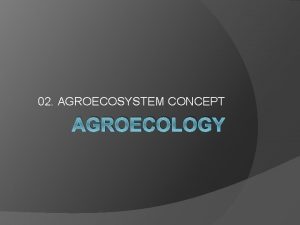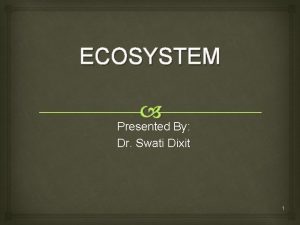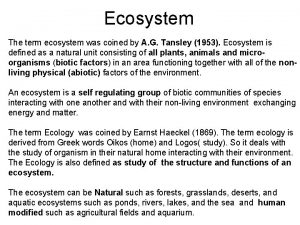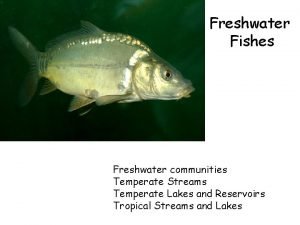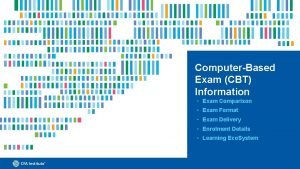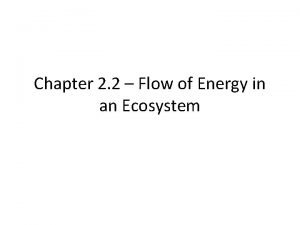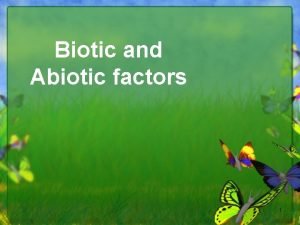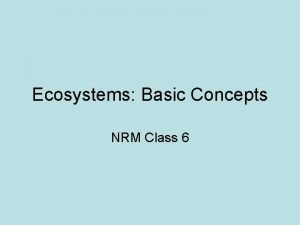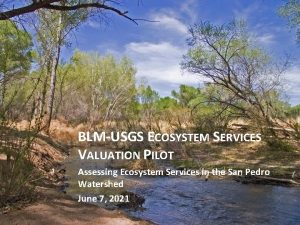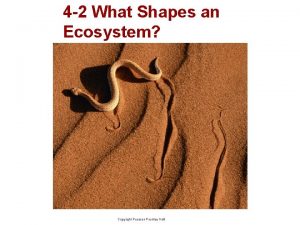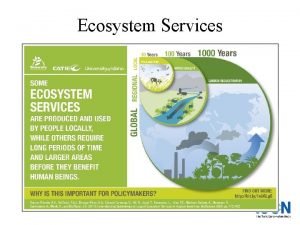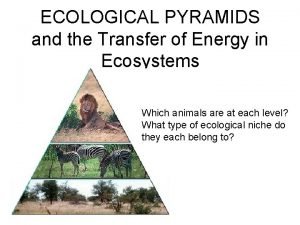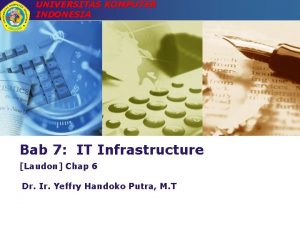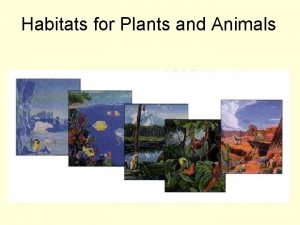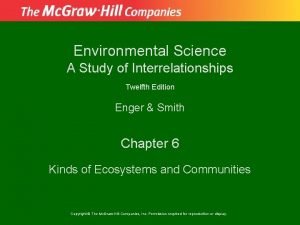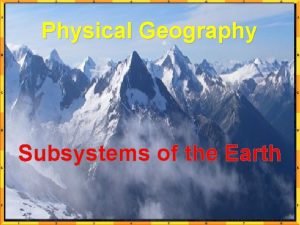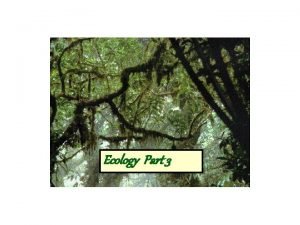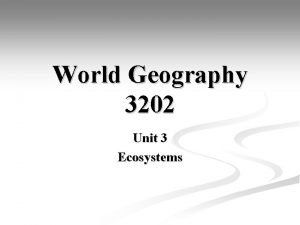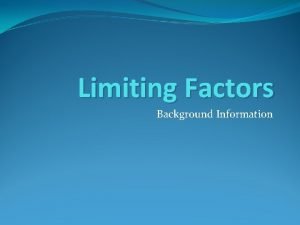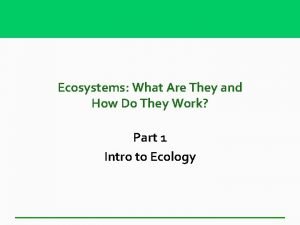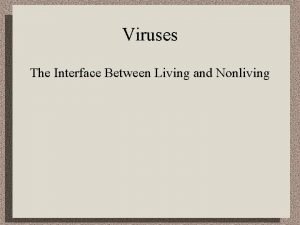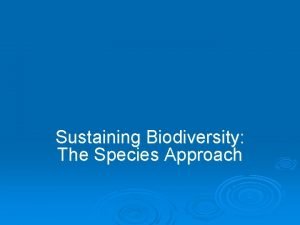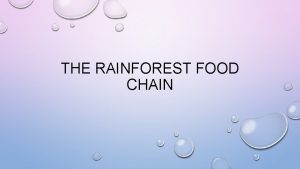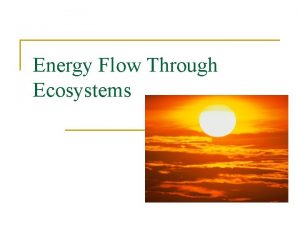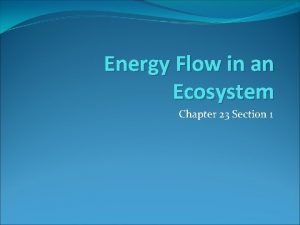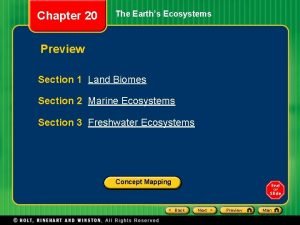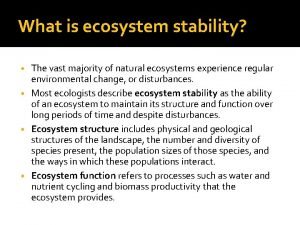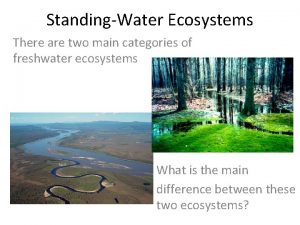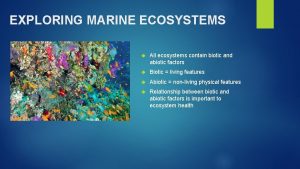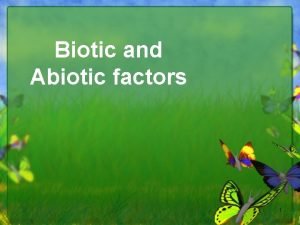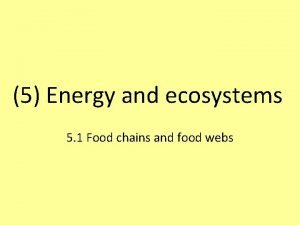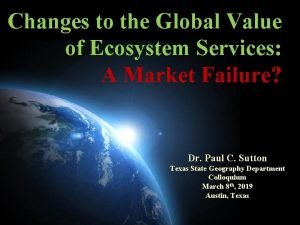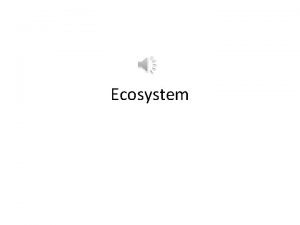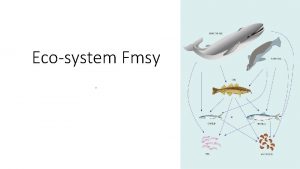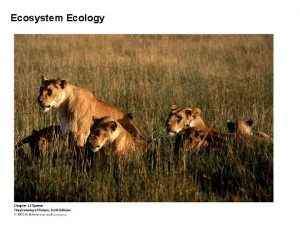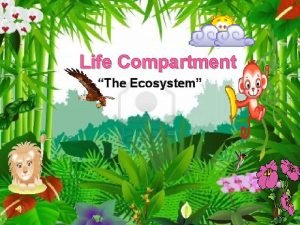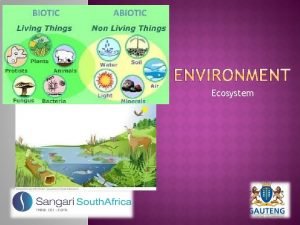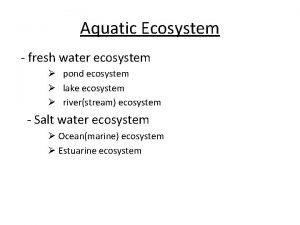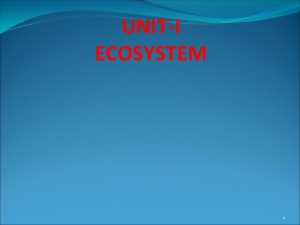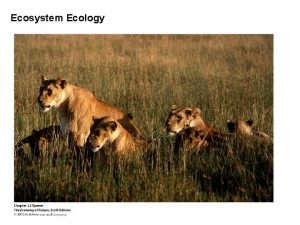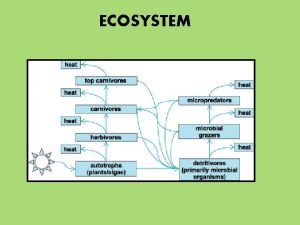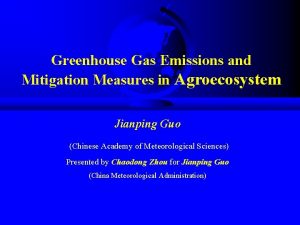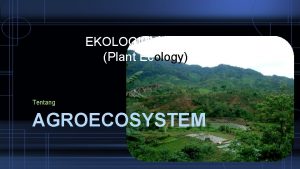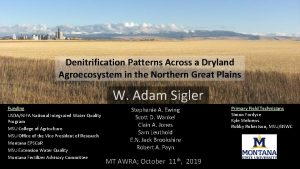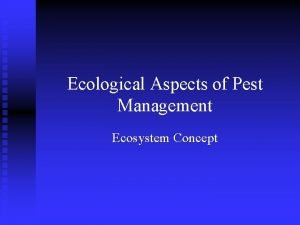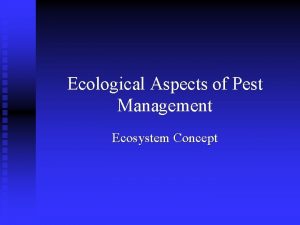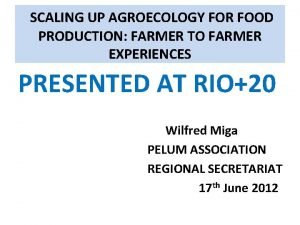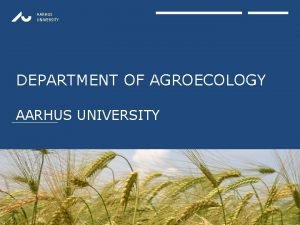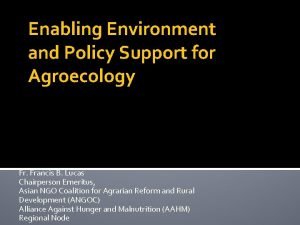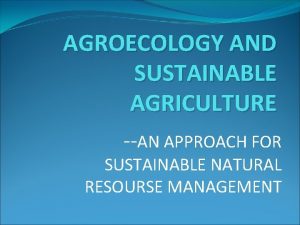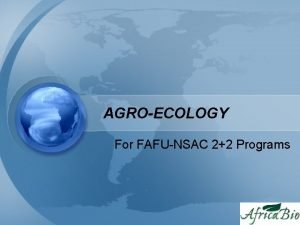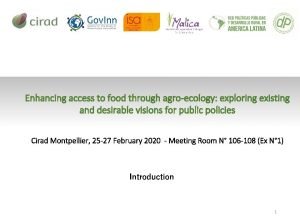02 AGROECOSYSTEM CONCEPT AGROECOLOGY What is an ecosystem














































- Slides: 46

02. AGROECOSYSTEM CONCEPT AGROECOLOGY

What is an ecosystem, and how can we study one? � Is the earth an open or closed system with respect to energy and elements? � How do we define "biogeochemical cycles, " and how are they important to ecosystems? � What are the major controls on ecosystem function? � What are the major factors responsible for the differences between ecosystems? �

The concept of the agroecosystem is based on ecological principles NATURAL ECOSYSTEMS

Gen Sel Organisme Populasi Komunitas Mineral/materi Sel Organ Sistem Organisme Sistem Populasi Sistem Gambar. Spektrum Ekologi Ekosistem

Organization of Life Biosphere Ecosystems Communities Populations Organisms

Scales of Ecological Organization

INDIVIDU? POPULASI ? KOMUNITAS ? C A B

INDIVIDUAL ORGANISM Molecules Cells Tissues Organs systems Autecology/Physiological ecology Concerned : how is a organism response the environmental factors? How is a individual organism tolerance to stresses in environment where it will live? Organism

POPULATIONS �A population is a group of individuals of the same species inhabiting the same area at the same time. � Important characteristics: ○ Population size, density, and dispersion ○ Birth and death rates ○ Growth rates ○ Age structure ○ Genetic Diversity

Characteristics of Populations 1. 2. 3. 4. 5. Population size, density, and dispersion Birth and death rates Growth rates Age structure Genetic Diversity

POPULATIONS Population ecology � Concerned : Important in determining the factors that control population size and growth relation to the capacity of the environment to support population over time

Population Ecology �A population is a group of plants, animals, or other organisms, all of the same species, that live together and reproduce. � The important of population ecology 1. Numbers of individuals in a population 2. Population dynamics: how and why those numbers increase or decrease over time 3. Population ecologists try to determine the processes common to all populations

Population Ecology in Action � Biologists in applied disciplines such as �Forestry �Agronomy (crop science) �Wildlife management � Must manage populations of economic importance � Prevent threatened or endangered species from extinction

COMMUNITIES � Communities an assemblage of populations of many species living together in the same location at the same time. � The important thing : 1. Community structure and functioning 2. Community Biodiversity ○ Number and types of species ○ Relative abundance of species ○ Interactions among species 3. Community Development ○ Community resilience to disturbance ○ Nutrient and energy flow

COMMUNITIES Community ecology � Concerned : How the interactions of organism affect the distribution and abundance of the different species

ECOSYSTEMS � Ecosystems are composed of all the communities and their physical, chemical, and biological processes. �Ecosystems sustain themselves entirely through energy flow through food chains, and nutrient recycling.

Example: In Watershed

Components of Ecosystem ABIOTIC COMPONENTS Sunlight Primary producers Temperature Herbivores Precipitation Carnivores Water or moisture Omnivores Soil or water chemistry (e. g. , P, NH 4+) Detritivores etc. All of these vary over space/time

Biosphere The biosphere is the global sum of all ecosystems. It can also be called the zone of life on Earth. From the broadest biophysiological point of view, the biosphere is the global ecological system integrating all living beings and their relationships, including their interaction with the elements of the lithosphere, hydrosphere and atmosphere

Structural Properties of Communities � Species Diversity � Dominance and Relative Abundance � Vegetative Structure (ex: grassland, forest ) � Trophic Structure � Stability



Figure. Relationships within an ecosystem

NATURAL ECOSYSTEM

Processes of Ecosystems How ecosystems function: 1. Ecosystems have energy flows and ecosystems materials cycles. 2. Ecosystems have nutrient cycles

1. Energy flows and materials cycles Figure. Energy flows and material cycles.




2. Energy flows and nutrient cycles Figure. Relationship between energy flow and nutrient cycle

Biochemical cycles in ecosystem 1.


2. The carbon cycle


3. The phosphorus cycle


AGROECOSYSTEM

AGROECOSYSTEM VS. NATURAL ECOSYSTEM � Natural ecosystem is closed, or at least, unmanaged ecosystem � Closed ecosystem—all elements recycled through ecosystem— not often pure closed ecosystems anymore—humans frequently involved � Agroecosystem is an open ecosystem, or managed ecosystem: � Producer moves plants, animals, environmental factors (fertilizers, feed) in & out of ecosystem � Will not continue on its own without management � If left alone, would progress toward closed ecosystem, but probably not the same as original ecosystem before agriculture without human input again

Characteristics Productivity Species diversity Genetic diversity within species Plant life-cycles present Competition Flowering, plant maturing Nutrient Cycles Permanence Human Control Ecological Maturity Agroecosystem High Low (monoculture) —can use crop rotation and intercropping to stabilize more Low Few Natural Ecosystem Low High Synchronized All, more perennial Tolerable (ecological niche) Seasonal Open Short High Early, immature Closed Long Low Mature, climax Negative

ENERGY FLOW

Figure 2. 7 Functional components of an agroecosystem.

POPULATION REGULATING MECHANISM Crop Populations Natural Plant Population (also true of weeds) Seed brought in by producer Seed produced mostly by local plants High seed viability Uniform seed dispersal Low dormancy, carryover of seed Variable seed viability Non-uniform seed dispersal Possibility of dormancy, delayed germination (carryover) Uniform soils Uniform population age, genetics Variable soil types Diverse population age, genetics Even spacing within species Variable spacing within species High allocation of plant resources to reproduction (seed) Allocation to seed production may be lower

NUTRIENT CYCLING NATURAL ECOSYSTEM AGROECOSYSTEM Ø Inputs: Plant residue Animal wastes Animal residue Atmosphere Nitrogen fixation Ø Using the soil as a pool of nutrients: Ø Inputs: Fertilizers Crop residues Atmosphere Nitrogen fixation Ø Outputs: Crops then removal from area Erosion Leaching Ø Run-off www. themegallery. com Ø Outputs: Plants animals grazing on plants Denitrification Run-off leaching Company Logo


ASSIGNMENT 1. Cari contoh suatu ekosistem. 2. Tuliskan semua komponen yang ada di dalam komunitas tersebut 3. Jelaskan proses yang terjadi di dalam komunitas tersebut

 Energy flow and material cycling in ecosystem
Energy flow and material cycling in ecosystem Introduction to agroecology:
Introduction to agroecology: Example of grazing food chain
Example of grazing food chain Concept of ecosystem is coined by
Concept of ecosystem is coined by Describe your real self example
Describe your real self example Pengertian marketing concept
Pengertian marketing concept -is an example of a lentic ecosystem.
-is an example of a lentic ecosystem. Cfa cbt results
Cfa cbt results Principles of ecology 2 flow of energy in an ecosystem
Principles of ecology 2 flow of energy in an ecosystem Pond
Pond Compare and contrast community and ecosystem
Compare and contrast community and ecosystem Food chain for class 6
Food chain for class 6 What are ecosystem services?
What are ecosystem services? Copyright
Copyright Ecosystem services
Ecosystem services Pyramid of energy in ecosystem
Pyramid of energy in ecosystem It infrastructure ecosystem
It infrastructure ecosystem What is habitat
What is habitat Intraspecific competition
Intraspecific competition Levels of organization in an ecosystem
Levels of organization in an ecosystem Tansley 1935 ecosystem
Tansley 1935 ecosystem Ecosystem vs community
Ecosystem vs community Zones in lake ecosystem and types of organisms present
Zones in lake ecosystem and types of organisms present Lithosphere ecosystem
Lithosphere ecosystem Pond succession
Pond succession Characteristics of an ecosystem
Characteristics of an ecosystem What is a limiting factor in biology
What is a limiting factor in biology What is the role of decomposers in the ecosystem?
What is the role of decomposers in the ecosystem? What ecosystem
What ecosystem Detritus food chain
Detritus food chain Erp ecosystem
Erp ecosystem Sustaining biodiversity the species approach
Sustaining biodiversity the species approach Producer in the tropical rainforest
Producer in the tropical rainforest What are the energy roles in an ecosystem
What are the energy roles in an ecosystem What is the 3rd level consumer
What is the 3rd level consumer Freshwater ecosystem abiotic factors
Freshwater ecosystem abiotic factors 5.04 quiz: ecosystem stability
5.04 quiz: ecosystem stability Chaparral food chains
Chaparral food chains What are the two main categories of ecosystems
What are the two main categories of ecosystems Biotic and abiotic components of marine ecosystem
Biotic and abiotic components of marine ecosystem Pond ecosystem biotic and abiotic factors
Pond ecosystem biotic and abiotic factors How does energy enter an ecosystem? *
How does energy enter an ecosystem? * Changes in the global value of ecosystem services
Changes in the global value of ecosystem services Types of biodiversity
Types of biodiversity How does energy flow through an ecosystem
How does energy flow through an ecosystem 4-4 aquatic ecosystems
4-4 aquatic ecosystems Data
Data
